McIntosh MHA100
Headphones and integrated amplifier with DAC review
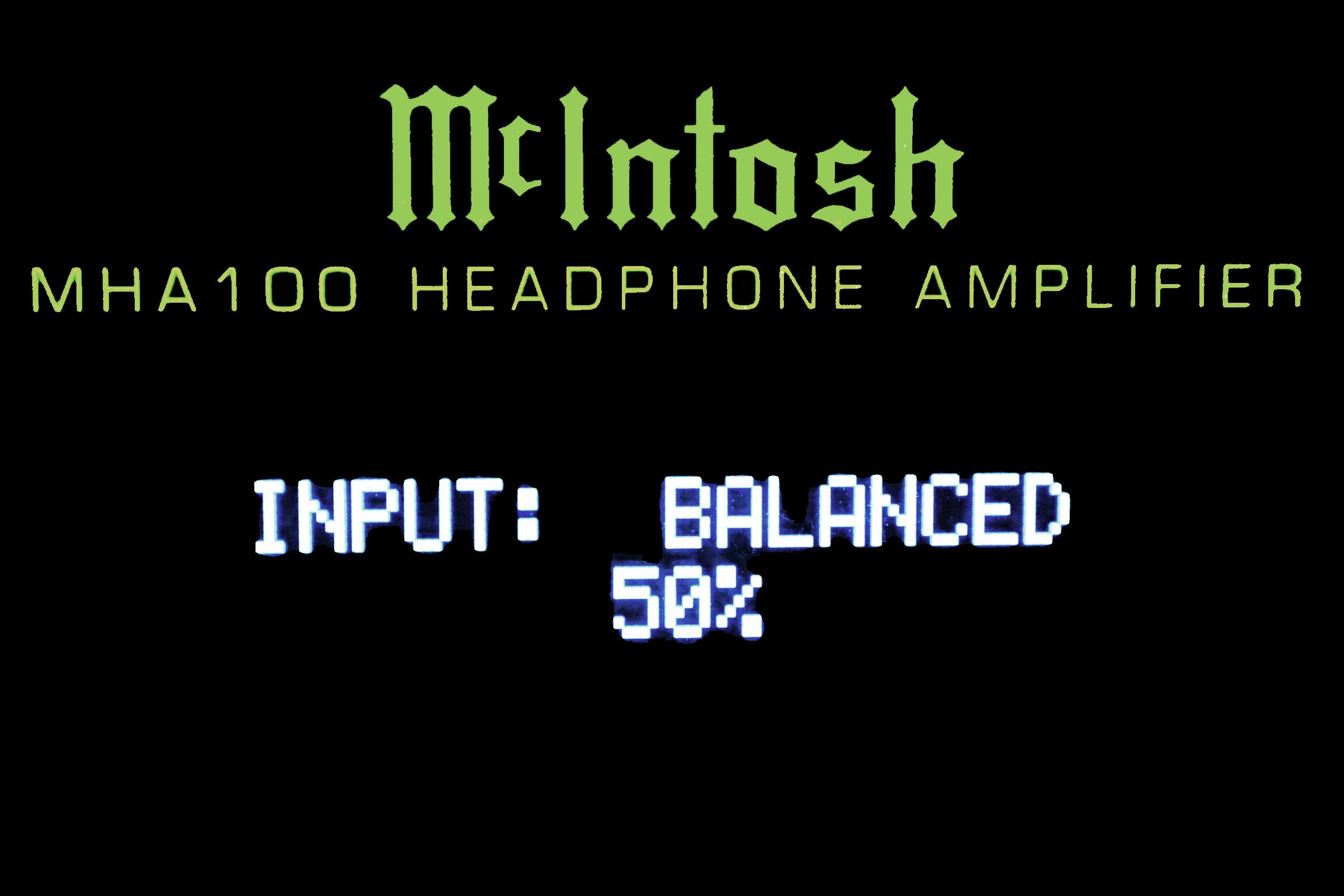
Introduction
The headphone market is a strange one because, while on the one hand some say that this is a temporary phenomenon destined to wane and on the other it attracts a growing number of enthusiasts who are ready to spend large sums on their headphone systems.
This has led to the development of high performance headphones and the parallel development of a whole series of devices dedicated to them, incorporating different sonic and technical solutions. The latest trend is to provide enthusiasts with an all in one product that incorporates everything needed to create a headphone system. We refer in particular to products which, within a single chassis, have a headphone amplifier, a DAC, and if necessary a speakers amplifier. This is what McIntosh did, a company that in the world of high fidelity needs no introduction and which has decided to forcefully enter the market of headphones and headphone amplifiers offering a product that will meet, as a whole, even the most die-hard audiophile needs. Its latest addition, the MHA100 lacks nothing and is in fact a headphone amplifier, a DA converter and a speakers amplifier with a complete range of inputs and outputs. A very interesting product that we wanted to try for you.
Design
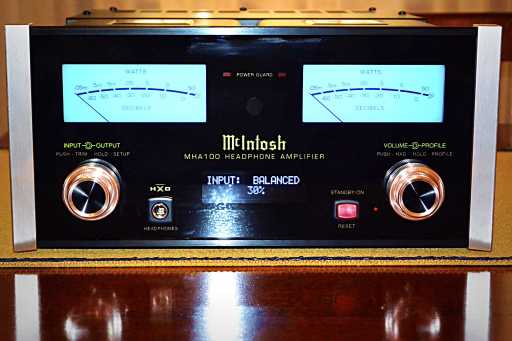
There is no doubt that McIntosh wanted to impart to the product, both its technological know-how acquired over the years and the classic and elegant design that has always set it apart. Immediately the MHA100 gives you the feeling it is solidly constructed, due to the fact that you can feel all of its 15 kg, and its beauty is enhanced by the original front panel display and the popular blue VU meters, that have made McIntosh world famous and which hide a number of technical refinements. In particular, the LED backlight has a much faster response than the classic VU meter, while the display uses OLED technology, and indicates all functions of the device allowing you to adjust brightness depending on the environment. The buttons on the front panel use the electromagnetic switching technology to prevent wearing typical of normal metal buttons, while the volume attenuator allows gain increases up to a margin of 0.5 dB.
The technological know-how of McIntosh, which we mentioned at the beginning, allows the MHA100 to use the auto-transformers technology that sets the amp to work in the best possible conditions and be unaffected by either changes in load, or impedance typical of many headphones on the market today. For this purpose, the MHA100 offers the opportunity to choose between three different impedances: 8–40 ohms, 40–150 and 150–600 ohms to allow the use of different types of headphones, which today is pretty common amongst headphone lovers equipped with a large number of headphones both dynamics and ortodynamics ones. In addition to the technology of auto-transformers, McIntosh wanted to include in this new exclusive amplifier, the HXD, in order to exploit the principle of crossfeed and simulate speakers listening through headphones. Not satisfied with the parterre of this technology, McIntosh decided to add a bass enhancer in progressive steps of 2.5 dB and let the user store different configurations by choosing the type of digital inputs (AES-EBU, S/PDIF, TOSLINK and USB). As well as balanced analog XLR and unbalanced RCA, it also provided classics terminals to connect the speakers and an internal DAC that supports resolutions of up to 24 bit 192 kHz. Finally, the power of the speakers amplifier is 50 watts on an 8 ohm load, while the headphone power output is 1 watt on the HIGH position and 250 mW on the LOW position.
Listening test
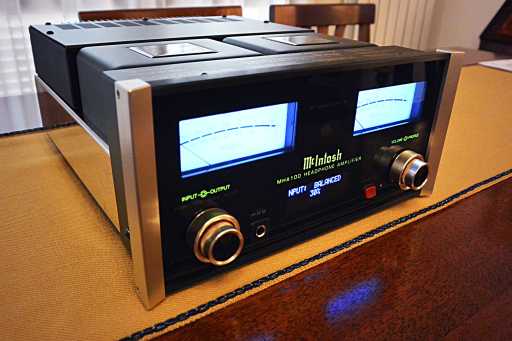
We don’t deny that we were prepared to test this high-end product with a certain expectation. After all, the brand is held in high esteem by fans and therefore we wanted to create the best possible conditions for the listening test in our small studio. We therefore left the MHA100 to burn-in for a week before any critical listening and we replaced the power cord with a custom one built to our specifications by Airtech. For the pure headphone amplifier section we then compared it with our current reference the Bryston BHA-1, while the DAC section, was compared with the Tobby by Firestone Audio. As regards the headphones, we used the Sennheiser HD 650, HD 800 and the Audeze LCD-X, all connected in unbalanced mode to the MHA100. The audio tracks used for the listening test included recordings at different resolutions and of different dynamic ranges. We limited our test to a comparison of the product as a headphone amplifier and DAC thereby omitting its ability to drive speakers. The listening trial began with the use of the Audeze LCD-X. Right away we noticed a great stereo image with a large opening and a fairly precise location of instruments. The timbre of the MHA100 struck us for its crispness and linearity at high and mid-high frequencies, even at high pressure sound levels. Compared to the Bryston, the McIntosh returns the bass drier and with minor impact. It’s apparent that the LCD-X gains considerably in performance when connected in balanced mode to the BHA-1 and compared to normal use in unbalanced mode with the MHA100.
When moving on to a high-impedance headphone like the Sennheiser HD 650 and by setting the impedance at 150-600 ohms, we found equally positive listening sensations. The pure and linear tone of the MHA100 greatly helps the HD 650 to bring out its best. The yield of voices and instruments stood at consistently good levels. High frequencies are very precise and don’t cause any fatigue. The yield of the midbass frequencies gives a greater presence especially when compared with those expressed by the BHA-1. Clearly, the MHA100 is much more comfortable with high impedance headphones like the HD 650 than with low impedance ones. In all honesty, we liked the excellent combination with the HD 650 so much that we didn’t regret the one between the Sennheiser headphone and the Bryston in balanced mode. With its older sibling the HD 800 the story was quite different. The pretty clean tone of the amp in our view doesn’t fit completely to the open one of the Sennheiser HD 800 and it doesn’t help unleash its full potential. In particular, the yield on the low frequency turned out to be less authoritative, drier and slightly depleted compared to that one expressed in combination with the Bryston. But where the HD 800 recovered a good number of points was when it was used with the HXD function exclusive on the MHA100.
Of all the headphones tried, the best results were achieved using this function with the HD 800 which enabled it to express much of its potential by unleashing a far more convincing low frequency than when the HXD was not activated. So we have to admit, as we have seen on other occasions, that you shouldn’t fear trying different combinations available on a product. In this sense McIntosh has given its all to really satisfy demanding users like us at HDPhonic. The next part of the test was held using the MHA100 as a DA converter. We didn’t detect any differences in sonic performance among these multiple different digital inputs and in the end we focused on the USB one. The driver, developed by CEntrance, however, hasn’t proved easy to install and our audio workstation took a couple of restarts before the MHA100 was recognized as an audio device. We also found it a bit complicated to manage different playing programs and in locking the different sampling rates. Having overcomed these difficulties we were able to compare the MHA100 with our reference. From the beginning the McIntosh seemed slightly less detailed than the Tobby especially in the upper extremes. On the other hand, the MHA100 has expressed a greater roundness at lower frequencies than the Firestone, however expressing quite pleasant results, with an overall rather neutral performance. Some improvement occurred with the use of the iPurifier by iFi Audio especially as regards the focus and the articulation of transients that turned out pretty well.
Final thoughts
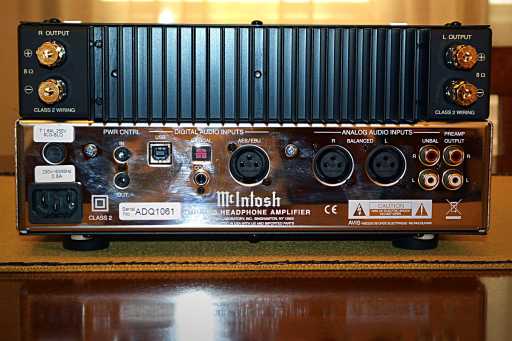
Given the high price of the device and the end-user to whom it’s addressed, we can say that expectations have been met in full. The McIntosh doesn’t stray far from what has always been the timbre which over the years has distinguished this brand. The MHA100 has provided very interesting benefits as regards the headphones amplification section and is able to satisfy the needs of a good number of headphones lovers looking for a good sounding product and a very attractive one from an aesthetic point of view. Used solely as a DAC the results provided by the MHA100 are within the range but perhaps require one to look elsewhere for what concerns the digital to analog conversion. However, if you are a fan of the brand and its sound, we can only recommend the MHA100 as a complete sound system of reasonable size that can offer you that for which McIntosh has become a must have over the years.
Personal Opinion
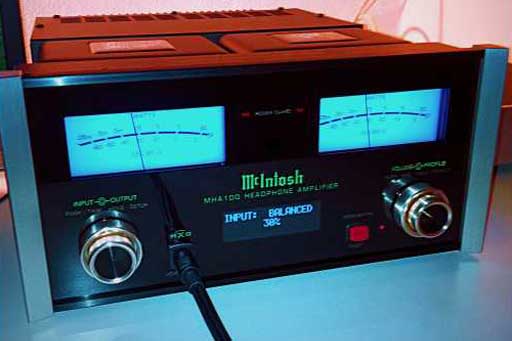
The tradition in the hi-fi field, at both a commercial and design level, often requires brands to follow some rules that eventually preclude a viable expansion towards other areas of high-fidelity. Fortunately, not all are so rigid in their positions and decide to open up new markets such as that of headphones, both for purely marketing reasons and to fulfill the needs of their loyal customers. This is what McIntosh did and the MHA100 is the result of this choice. The outcome is an aesthetically pleasing product that everyone wants to keep in their living room not only for the sheer visual pleasure of those blue color VU meters that make it immediately recognizable, but also for its accuracy and sturdy construction. In addition the versatility of the design makes it a versatile amplifier able to adapt to all types of listenings and digital inputs. Its only limit, although easily balanced by everything else, is the DAC for which I believe there is room for improvement, and above all the overall performance has to be reviewed. In conclusion, if I were an out and out audiophile looking for a complete device, the MHA100 would be first on my list. I said if I was… because at that price the MHA100 still remains a remote dream.
Score
- Scoring110
- Sound quality [1]
8 - Bang for the buck [2]
6 - Measures [3]
8 - Build quality [4]
10 - Versatility [5]
10 - Overall rating
8
- 1. The sound quality stands at good levels
- 2. The bang for the buck doesn’t make it a product accessible to all
- 3. The measurements show very good values on different parameters
- 4. The build quality is excellent and the look is very pleasant
- 5. Versatility is wide-ranging and the utilizitation can be multiple








